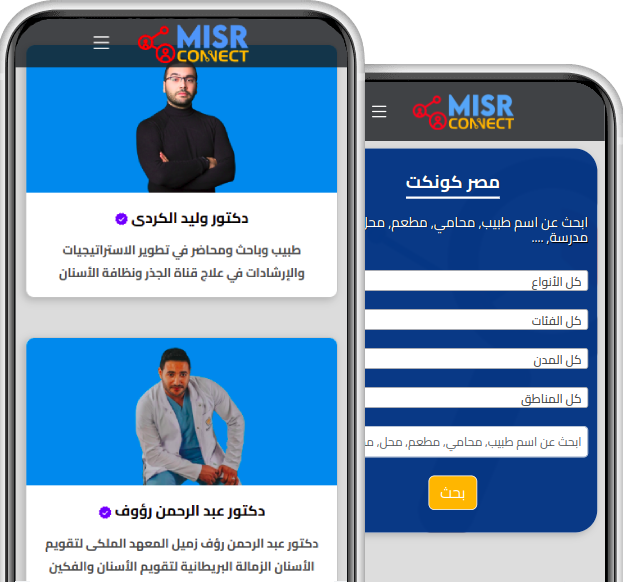Dr. Yasser Mohamed Ahmed Abdel Kareem
Consultant in Respiratory Diseases

- Name: Dr. Yasser Mohamed Ahmed Abdel Kareem
- Phone: 0972315360
- Area:
🩺 Dr. Yasser Mohamed Ahmed Abdel Kareem
Consultant in Respiratory Diseases
🌟 Specializations:
👶 Congenital Respiratory Diseases
Description: These include respiratory problems present at birth, such as congenital deformities or developmental issues in the lungs or airways that can affect breathing.
Examples: Problems with lung development or other congenital disorders leading to breathing difficulties from birth.
💔 Respiratory Diseases Associated with the Circulatory System
Description: This deals with respiratory diseases caused by heart or blood vessel issues, such as pulmonary hypertension, which occurs when blood cannot flow normally through the lungs.
Examples: Congestive heart failure or pulmonary artery diseases that increase blood pressure in the lungs.
🌬️ Lung Diseases
Description: This category includes diseases affecting lung tissue, such as pneumonia, Chronic Obstructive Pulmonary Disease (COPD), pulmonary fibrosis, and tuberculosis.
Examples: Pneumonia (bronchitis or pneumonia), chronic lung diseases such as pulmonary fibrosis.
🛡️ Immune-related Lung Diseases
Description: These occur when the immune system attacks healthy lung tissue, leading to chronic inflammation and lung damage.
Examples: Asthma, allergic bronchitis, and lung inflammation caused by autoimmune diseases like lupus or vasculitis.
🤧 Chest Allergies
Description: These diseases involve allergies affecting the respiratory system, such as allergic asthma or chest allergies triggered by environmental factors like dust, pollen, or smoke.
Examples: Allergic asthma, allergic rhinitis that can lead to difficulty breathing or asthma attacks.
💨 Pulmonary Hypertension
Description: A medical condition resulting in increased pressure in the blood vessels supplying the lungs, causing the heart to work harder to pump blood through the lungs, which leads to shortness of breath.
Examples: Pulmonary hypertension caused by heart or respiratory diseases.
🔬 Diagnostic and Therapeutic Lung Endoscopy
Description: Using small cameras (endoscopes) to examine the airways and lungs from the inside. This helps in diagnosing respiratory diseases and treating conditions like removing tumors or taking biopsies for lab tests.
Examples: Performing a bronchoscopy to take a tissue sample or check for blockages or tumors in the airways.
😴 Sleep-related Breathing Disorders
Description: Deals with breathing problems during sleep, such as sleep apnea or obstructive sleep apnea syndrome, which affects oxygen levels in the blood during sleep.
Examples: Testing and measuring breathing functions during sleep to treat conditions like sleep apnea or breathing difficulties at night.
📍 Clinic Address:
Kasar El Hajar Street - Aswan
📞 Phone Number:
0972315360
FAQ
Pneumonia is an infection in the lungs, and it shows through the following symptoms:
1. Cough: It could have mucus or it might be dry.
2. High fever: Fever with chills (feeling cold with heat).
3. Difficulty breathing: Feeling like you can't take a deep breath.
4. Chest pain: The pain gets worse when you breathe deeply or cough.
5. Fatigue and exhaustion: Feeling extremely tired, unable to get up.
6. Loss of appetite: Not feeling like eating as usual, and sometimes feeling nauseous.
7. Excessive sweating: Especially at night.
8. Muscle aches: Feeling body aches like you have the flu.
9. Mental confusion: Older adults may feel confused or have trouble thinking clearly.
Note: These symptoms can be severe or mild depending on age and health condition.
The recovery time from pneumonia depends on the severity of the condition and the patient's age:
1. Mild cases: Recovery usually takes 1 to 3 weeks.
2. Severe cases or elderly patients: Recovery may take 6 to 8 weeks or longer.
Tips for faster recovery:
1. Get plenty of rest.
2. Stay hydrated by drinking lots of fluids.
3. Follow your doctor’s instructions and take all prescribed medications.
If complications arise or symptoms persist for an extended period, consult your doctor immediately to prevent further health issues.
Pneumonia is an infection that affects the lung tissue itself. This means the air sacs in the lungs become inflamed and may fill with fluid or pus. Its symptoms are clear and include:
1. High fever with chills.
2. Severe coughing, often accompanied by mucus or phlegm.
3. Difficulty breathing, and sometimes chest pain during deep breaths or coughing.
Bronchitis, on the other hand, is an inflammation of the tubes that carry air to the lungs (bronchial tubes). It’s often caused by viral infections or continuous smoking. The main symptoms are:
1. Persistent cough (which may be dry or produce mucus).
2. A feeling of tightness or mild pain in the chest.
3. Wheezing sounds when breathing.
4. General fatigue and exhaustion.
In summary, pneumonia directly impacts the lungs and tends to be more severe, while bronchitis affects the airways leading to the lungs and doesn’t involve the lung tissue itself.
Yes, pneumonia can be contagious, especially if it's caused by bacterial or viral infections. The infection can spread from one person to another through:
1. Coughing and sneezing: From an infected person.
2. Direct contact: Such as shaking hands with someone who is sick.
3. Contaminated air: Inhaling air that contains germs.
To reduce the risk of infection, it’s important to wash your hands frequently, avoid direct contact with sick individuals, and wear a mask if you’re in crowded areas or around infected people.
Symptoms of bronchitis may include:
1. Persistent cough: It can be dry or accompanied by mucus.
2. Difficulty breathing: You might hear wheezing (a whistling sound when breathing).
3. Chest discomfort: A feeling of tightness or heaviness in the chest.
4. Fever: A slight increase in body temperature.
5. General fatigue: Feeling tired and drained most of the time.
6. Nasal congestion or sore throat: A stuffy nose or throat pain might occur.
Note: Bronchitis is often caused by a viral or bacterial infection. The cough may persist even after other symptoms improve.
Bronchitis (acute bronchial inflammation) is usually not dangerous if treated properly. However, in some cases, complications can occur, such as:
1. Chronic bronchitis: If it lasts for a long time or if flare-ups are frequent.
2. Underlying health conditions: Conditions like asthma or heart diseases may increase the risk of complications.
3. Age and weakened immune system: The body may be less able to fight off infections.
4. Rare complications: Such as progression to pneumonia or breathing difficulties.
It is important to consult a doctor when symptoms appear to ensure appropriate treatment and prevent complications.
